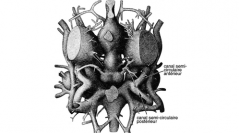

 Comptes Rendus Palevol
5 (3-4) - Pages 637-655
Comptes Rendus Palevol
5 (3-4) - Pages 637-655The semicircular canals of the labyrinth of vertebrates provide one way of motion detection in a three-dimensional space. The fully developed form of the vertebrate labyrinth consists of six semicircular canals, three on each side of the head, whose spatial arrangement (two pairs of vertical canals is placed diagonally in the head, one pair of horizontal canals is oriented earth horizontally) follows three interconnected principles: (i) bilateral symmetry, (ii) mutual orthogonality, (iii) push-pull operational mode. Motor systems related to the vestibular reflexes such as the extraocular muscles, or the neck muscles, share the same geometrical framework. This framework is also reflected in the anatomical networks mediating compensatory eye and head movements, linking each one of the semicircular canals to a particular set of extraocular muscles (so-called principal vestibulo-ocular reflex connections to yoke muscles) and to particular head–neck muscles. The particular spatial arrangement of the vertical semicircular canals is already present in fossil ostracoderms, however, lacking horizontal canals. Horizontal canals appear in gnathostomes. Their occurrence coincides with the expression of the Otx1 gene in the inner ear. The fully developed vertebrate labyrinth, with its six semicircular canals, displays distinct differences, which are obvious when comparing different taxa (e.g., elasmobranchs versus other vertebrates). Whereas the common crus of the semicircular canals in teleosts through mammals is formed between the anterior and the posterior semicircular canals, it occurs between the anterior and the horizontal canals in elasmobranchs. However, despite this morphological difference, these two vertebrate labyrinth prototypes constitute a functionally identical solution. A similar analysis holds for certain invertebrate species (squid, octopus, crab), which display an even wider variety in the physical expression of movement detection systems when compared to vertebrates. During morphogenesis, expression of certain genes guides the formation of particular inner ear structures, notably the development of hair cells by the Math1, and primary vestibular neurons by ngn1. A number of vertebrate genes are homologues of Drosophila genes. An exception is the Otx1 gene, which only occurs in vertebrates and is responsible for the formation of horizontal semicircular canals. Although the physical expressions of motion detection systems differ in the animal kingdom, the functional solutions (providing the best signal-to-noise ratio) with adherence to bilateral symmetry, mutual orthogonality and push-pull operational mode are identical. Furthermore, this functional principle is reflected in the intrinsic organization of related motor systems.
Labyrinth, Spatial orientation, Bipedalism, Movement coordination, Semicircular canals, Hominids, Vertebrates, Invertebrates